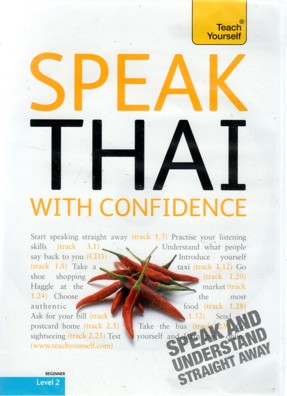Thai Conversation - Booklet and Audio CD - Learn to speak Thai

Teach Yourself Thai ConversationSpeak Thai with Confidence3 audio CDs by David MythMore Thai Language Learning click here |
 |
Teach Yourself Speak Thai with Confidence - 3 Audio CDs3 CDs all audio course by David Smyth We've all travelled abroad with the best of intentions when it comes to speaking the language, only to falter when it comes to the crunch. This quick and constructive course gives you the Thai you need to talk to the locals - and crucially, the confidence to put it into practice. As well as providing essential vocabulary and phrases, the course also aims to improve your understanding of spoken Thai, so that you can feel sure of yourself in two-way conversations. Based on the ten situations you are most likely to find yourself in while travelling abroad, the course builds your knowledge and understanding gradually, and is suitable for complete beginners. A booklet is included, with the dialogues and their English translations. A glossary of the words and phrases used also provides you with a handy phrasebook while you travel.By the end of this course, you will be at Level A2 of the Common European Framework for Languages: Can understand sentences and frequently used expressions. Can communicate in simple and routine tasks. TEN REALISTIC CONVERSATION SCENARIOS - the words and phrases you'll need Table of Contents: About the Author David Smyth:David Smyth spent several years teaching at universities in Thailand before taking up a post as Senior Lecturer in Thai at the School of Oriental and African Studies (SOAS), University of London. About the Thai LanguageThai is the national and official language of Thailand and the mother tongue of the Thai people, Thailand's dominant ethnic group. Thai is a member of the Tai group of the Tai-Kadai language family. The Tai-Kadai languages are thought to have originated in what is now southern China, and some linguists have proposed links to the Austroasiatic, Austronesian, or Sino-Tibetan language families. It is a tonal and analytic language. The combination of tonality, a complex orthography, relational markers and a distinctive phonology can make Thai difficult to learn for those who do not already speak a related language. Standard Thai, also known as Central Thai or Siamese, is the official language of Thailand, spoken by about 65 million people including speakers of Bangkok Thai . Khorat Thai is spoken by about 400,000 (1984) in Nakhon Ratchasima; it occupies a linguistic position somewhere between Central Thai and Isan on a dialect continuum, and may be considered a variant or dialect of either. In addition to Standard Thai, Thailand is home to other related Tai languages, including: * Isan (Northeastern Thai), the language of the Isan region of Thailand, considered by some to be a dialect of the Lao language, which it very closely resembles (although it is written in the Thai alphabet). It is spoken by about 15 million people (1983). Many of these languages are spoken by larger numbers outside of Thailand. Most speakers of dialects and minority languages speak Central Thai as well, since it is the language used in schools and universities all across the kingdom. Numerous languages not related to Thai are spoken within Thailand by ethnic minority hill tribespeople. These languages include Hmong-Mien (Yao), Karen, Lisu, and others. Standard Thai is composed of several distinct registers, forms for different social contexts: * Street Thai : informal, without polite terms of address, as used between close relatives and friends. Many Thais can speak at only the first and second levels, though they will understand the others.
|
Teach Yourself Speak Thai with Confidence - 3 Audio CDs |

 0 Items (Empty)
0 Items (Empty)
